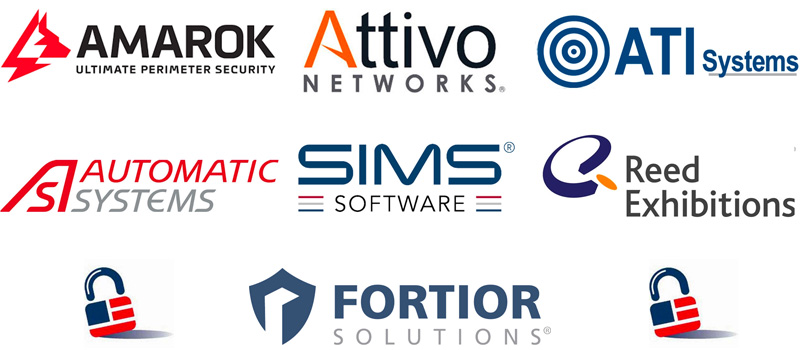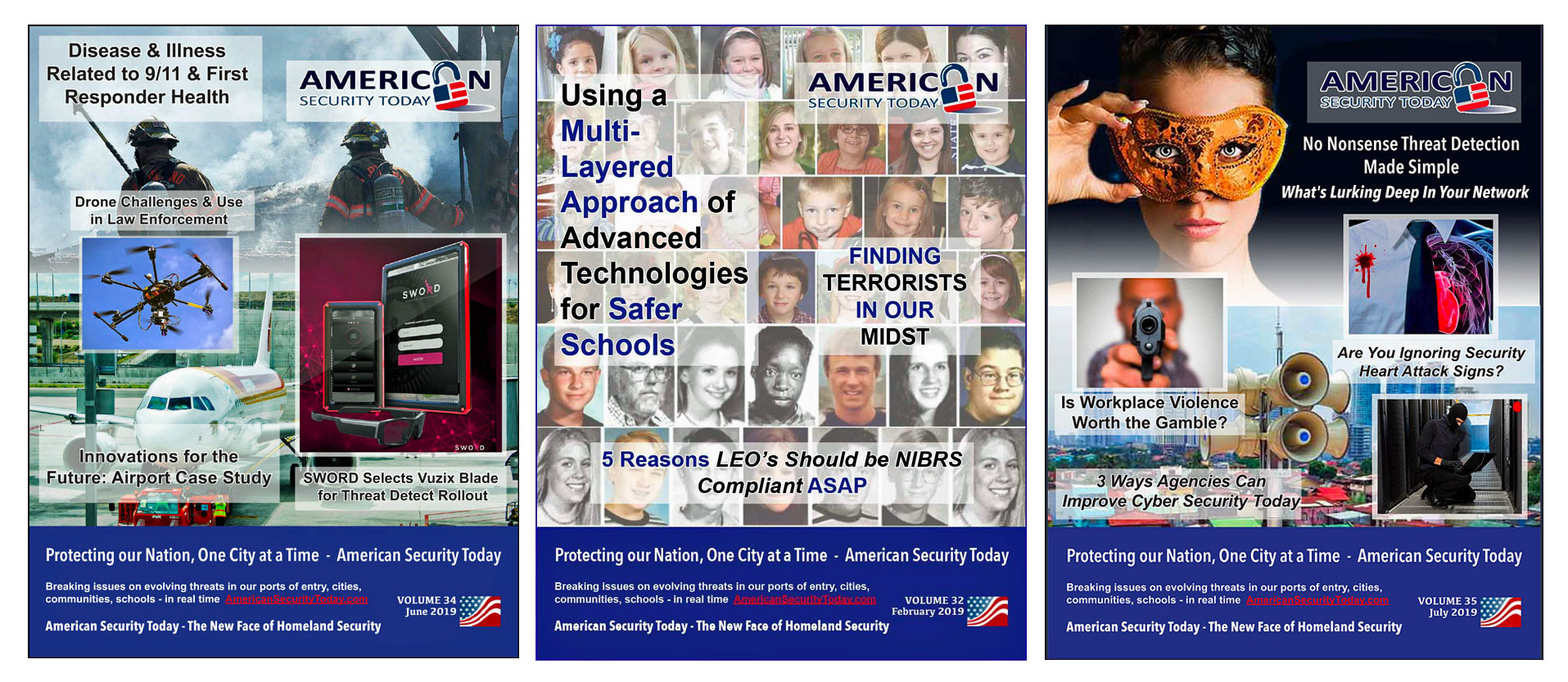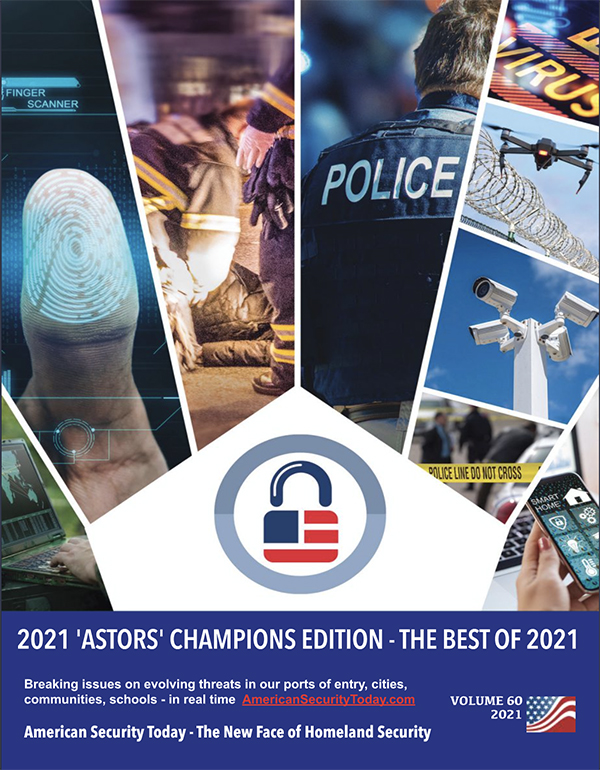
The last few years have been some of the most challenging for public safety in recent memory.
Pubic safety agencies have had to contend with the arrival of COVID-19, nationwide protests and public unrest that followed the murder of George Floyd, a historic rise in violent crime, and a general decline in goodwill toward first responders.
 It has been an exhausting few years that have seen many changes.
It has been an exhausting few years that have seen many changes.
The term “Reimagining Policing” came into common usage as part of a national conversation about the presumed mission of public safety agencies.
Responsibilities that were once considered basic functions of public safety are now being re-examined, leading many to ask, “How do we move forward?”
One thing has not changed: First responders remain committed to keeping communities safe.
As we enter 2022, it is critical that leadership identifies strategies and tools to guide agencies going forward.

“These past few years have been some of the toughest in recent memory for our first responders,” explains Matt Polega, Co-founder and Head of Communications & Public Policy at Mark43.
“As a partner and supporter of over 130 public safety agencies across the United States, our objective with the Mark43 2022 Public Safety Trends Report is to reflect on key learnings and identify the defining trends impacting agencies so that they can be empowered to make informed decisions in the year ahead.”
At Mark43, we believe that data is key to accomplishing public safety missions. Privileged to be working side-by-side with many innovative and tech-forward public safety agencies across the country, Mark43 is uniquely positioned to capture the challenges facing agencies in 2022 and provide actionable solutions to best serve their communities.”
Mark43 is a thought leader and expert in the public safety industry.

As a partner, supporter, and champion of the noble work of those working in the field, the company has taken the time to contemplate the future of public safety to better equip agencies for what is to come.
The Mark43 2022 Public Safety Trend Report is the result of comprehensive, thoughtful research, as well as conversations with industry leaders, public safety members, and Mark43 customers.
This report lays out six trends that Mark43 sees as defining public safety’s top focuses in 2022.
They have identified trends ranging from high-level topics impacting how agencies operate and interact with their communities to narrower themes specifically addressing data and employee recruitment.
Mark43 hopes you find this report insightful and looks forward to partnering with you in 2022 and beyond.
2022 Public Safety Trend Report
The Trends:
1. “Reimagining public safety” is not just a catchphrase — it is a critical next step
2. Data is key to improving relationships with all stakeholders
3. Modern, diverse workplaces are vital to public safety retention and recruitment
4. Mobile technology is critical to connect responders and enhance safety
5. As cyberattacks evolve, so must cyberdefenses
6. Consent decrees are here to stay
“Reimagining #publicsafety” is not just a catchphrase — it is a critical next step. Our 2022 Public Safety Trends Report defines major trends we believe will be the top focuses of the upcoming year and details the essential next steps for your agency. https://t.co/BpJ17We1vN pic.twitter.com/X4MCWDkZbW
— Mark43 (@mark43) December 15, 2021
Trend #1: “Reimagining public safety” is not just a catchphrase — it is a critical next step
In 2020, the U.S. saw the emergence of movements aimed at scaling back, ‘reimagining,’ or altogether eliminating the functions of law enforcement, particularly in the areas of crisis response and traffic stops.
In 2022, these calls will continue. Public safety agencies must be proactive in assessing their role in community interactions that have historically served as the epicenter for police-community tensions or risk having the changes imposed upon them.
The areas most impacted by this trend have been situations involving mental health crises and traffic stops.
“Our police and our fire departments have been, for many years already, highly overused for situations that have backgrounds and underlying issues in mental andbehavioral health.” 1 MARIELA RUIZ-ANGEL, Director of Albuquerque Community Safety
Changing crisis response.

Jurisdictions from Oakland to Denver and Austin to Boston are rethinking how they respond to mental and behavioral health crises.
Innovative co-responder programs, mobile crisis teams, and civilian-only responses are appearing in cities across the U.S. In 2022, reimagining public safety task forces will push their governments to implement policy recommendations crafted over the last 18 months.
Transforming traffic.
Expect 2022 to bring changes in the transportation and traffic sectors.
Americans are stopped more than 20 million times annually for traffic violations, making it one of the most frequent types of interactions between law enforcement and the public.
To reduce perceptions of bias in traffic stops and comply with ever-tightening budgets, municipalities like Washington, D.C., Berkeley, California, Brooklyn Center, Minnesota, and Philadelphia, Pennsylvania, have implemented unarmed civilian response to traffic stops such as broken taillights and other pretextual stops.

Philadelphia Council Member Isaiah Thomas, author of the Driving Equality Bill, which seeks to prohibit law enforcement from stopping drivers for low-level traffic violations, says, “Data will tell us if we should end more traffic stops or amend how this is enforced. Data will also tell other cities that Philadelphia is leading on this civil rights issue, and it can be replicated.”2
“Police pull over more than 50,000 drivers on a typical day, more than 20 million motorists every year.”3
Proactively partnering across departments and jurisdictions is how leading agencies are implementing the reimagined responses.
While the catchphrase may feel overused, it is finding meaning in cooperative public safety solutions.
The federal government acknowledges both the need for these programs and the associated costs.
The Bureau of Justice Assistance provides toolkits, grants, and free technical assistance to agencies ready to shape the modern public safety landscape.4
Key takeaways
-
Engage city leaders and community stakeholders early
-
Share information between agencies to help create tailored responses
-
Iterate and persist to meet the community’s evolving needs by use of rigorous analysis of data and sentiment gathering from the community and stakeholders
Trend #2: Data is key to improving relationships with all stakeholders
In recent years, public confidence in law enforcement has approached record lows5, especially in traditionally underserved communities.
In 2022, leading agencies will expand the use of data in their efforts to rebuild community trust.
Citizens are taking an active role in public safety problem-solving, and agencies are rethinking their engagement through three tenets: availability, accessibility, and authenticity.
Availability is the first, not the only, step in data sharing.
Historically, agencies have shared their data with the public through annual reports. This tendency satisfied the minimum requirements to make information available, but it does little to optimize public safety solutions or community relations.

To meet communities where they are, leading agencies are going beyond basic “availability” and are revamping their publishing schedules, databases, and websites with the end-user in mind.
Accessible data is key. People vary in their lived experiences, literacy levels, and other characteristics that shape how they receive and understand information.
Governments should deliver data with context and consideration into how the intended audience will perceive it.
Prioritizing structured data and engaging community members, or end-users, early and throughout the data exchange process is how leading agencies improve community relations.
Data is a means to an end, not the end itself. Increasing availability without offering interpretation is not enough.
The Rochester Police Department (RPD), in upstate New York, understood the importance of launching their open data portal and iterating based on community feedback over time.
RPD hosts a mobile-friendly webpage, provides codebooks to guide users through terminology, and integrates “open data into a greater community engagement and social media plan.”6
This story is only one example of 130+ member agencies’ efforts with the Police Data Initiative.
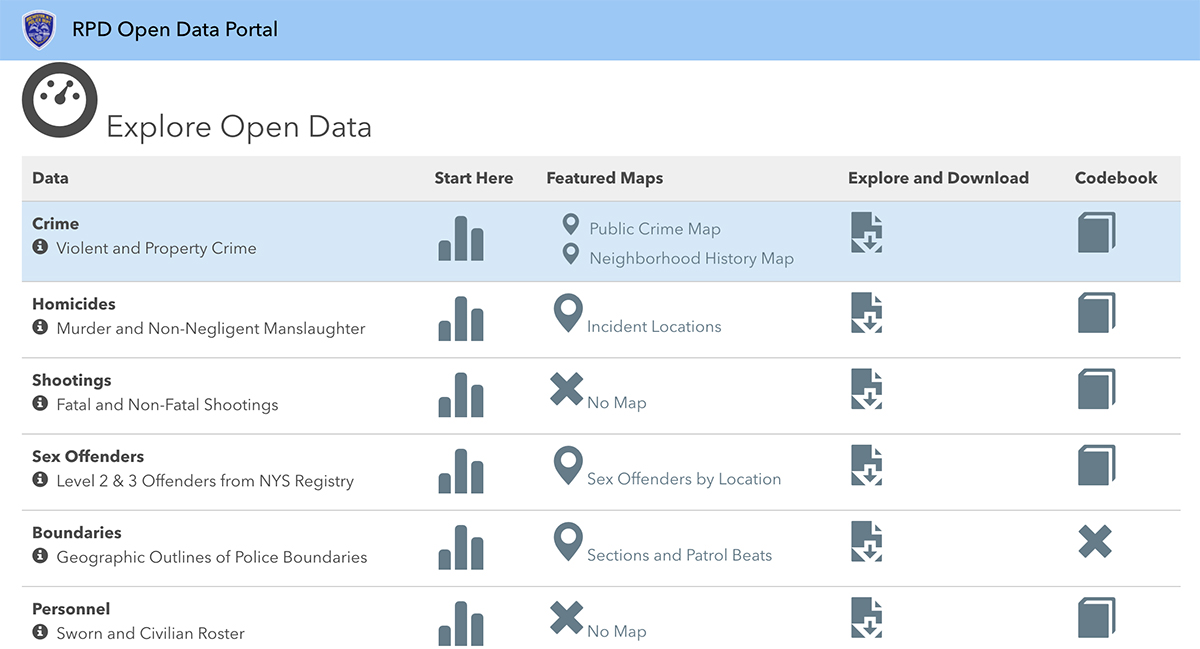
Authenticity is key to unlocking a community’s problem-solving potential. Engaging authentically means that all parties come to the table prepared to be open, vulnerable, and honest about their intentions.
If stakeholders can assume everyone present has good intentions, then they can connect as neighbors. This allows for more progress than would be made if stakeholders met just to receive data as statistics.
Roseanna Ander (University of Chicago Crime Lab) notes that “data is people — their lives, their experiences.”7
This is true for first responders and the communities they serve.
Approaching engagement regularly with authenticity sets the table for collaboration by allowing all parties to participate in root-cause analyses and share their stories and pain points.
Then through trust in each other and the data, they can collaboratively identify solutions.
(Take a look at the Crime Lab and some of its nonprofit and government partners. The Crime Lab works alongside community organizations and policymakers to design, test, and scale the most promising approaches to preventing violence, reducing the harms of the criminal justice system, and improving educational and life outcomes for Chicagoans. By doing this work in close partnership with the public sector, the Lab aims to help cities steer resources to the most effective approaches. Courtesy of Harris County Policy and YouTube. Posted on Oct 15, 2019.)
To go wide, go with government
To go deep, go with NGOs and academics
To go fast, go with the private sector
To go far, go together8
SHAMINA SINGH, President, Mastercard Center for Inclusive Growth
Key takeaways

1. Democratize the data—share it openly, regularly, and intentionally
2. Use an accessible data portal to engage in reciprocal information sharing between your agency and community
3. Practice authenticity to solve problems collaboratively; you will go farther together
Trend #3: Modern, diverse workplaces are vital to public safety retention and recruitment
The last two decades have seen a drop in the recruitment and retention of public safety employees.
In 2022, leading agencies will market themselves as modern workplaces. Modern workplaces for modern workers. Recruitment and retention are challenging areas for agencies.
Current and future responders expect a modern workplace that includes functional facilities and intuitive technology, but more importantly, one that prioritizes social responsibility, diversity, and inclusion.
Diversity matters.
The diversity index from the U.S. Census increased to 61.1 percent in 2020 from 54.9 percent in 2010,9 meaning American neighborhoods are becoming more diverse.
Communities thrive when they can see themselves represented in local policies, practices, and personnel.
Public safety agencies should set bold but attainable targets to increase diversity and continue developing workforces that are reflective of the communities they serve.
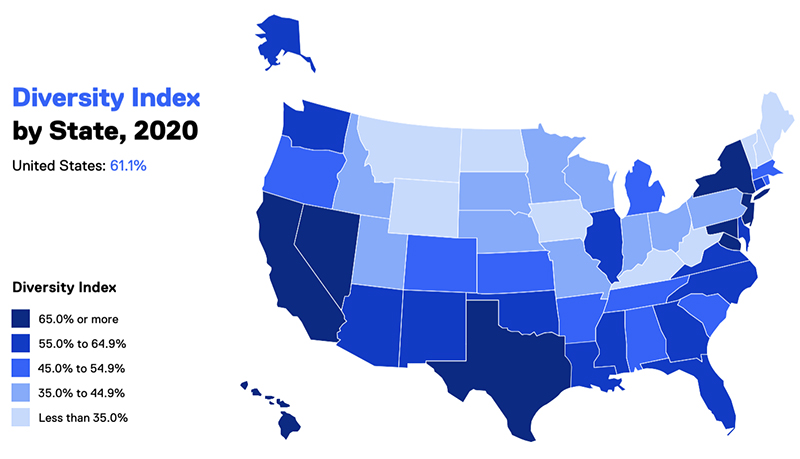
Recruit women.
Currently, women comprise only 21 percent of emergency medical service (EMS), 13 percent of sworn law enforcement, and eight percent of fire rescue.10
The number of leadership positions held by women across these professions hovers in the low single digits. This underrepresentation of women, particularly in policing, stifles public safety’s potential.

Research shows female officers use excessive force less often, are named in fewer complaints and lawsuits, are perceived by communities as more compassionate, make fewer discretionary arrests, and see better outcomes for crime victims, especially in sexual assault cases.
30×30, a national initiative to advance women in policing, has a primary goal: “to increase the representation of women in police recruit classes to 30 percent by 2030 and ensure police policies and culture intentionally support the success of qualified women officers throughout their careers.”11
(Learn about the 30×30 Initiative, courtesy of City of Des Moines – DMTV and YouTube. Posted on Nov 4, 2021.)
Recruiting more women into the field strengthens the public safety profession and our communities as a whole.
Key takeaways
1. Modernize your agency to recruit and retain talent
2. Prioritize diversity
3. Take the 30×30 Pledge to commit your agency to increase women recruits to 30% by 2030
Trend #4: Mobile technologies are connecting responders and increasing safety
Modern technologies offer first responders incredible situational awareness, and emerging technologies’ capabilities to increase first responder support are only limited by the imagination.
In 2022, the adoption of technologies that support first responder wellness and increase field efficiency will continue to grow.
Wearable technologies for responder wellness.
Wearable sensor technology (WST) is a good example of technology only limited by imagination. Today’s smartwatches can support officer wellness by proactively monitoring vital signs, sleep, and more.
Right information at the right time.

Equally important is technology that provides the right responder with the right information at the right time.
Context-driven mobile apps provide responders with the information they need at any particular moment.
For example, an app that provides in-field access to the agency’s records management system (RMS) means an officer does not have to wonder if they interacted with someone on the most-wanted bulletin board — they can look it up on their mobile app.
Mobile technologies also allow responders to easily record information from the field without returning to the office.
With the ability to document and report accidents in the field, officers finish reports faster and spend more of their shift with the community.
(Learn how Mark43 is building software for the future of law enforcement and public safety. The company envisions a world where all officers are able to collect and share data in real-time, from the scene and back at the station. As law enforcement evolves, Mark43 adapts. Courtesy of Mark43 and YouTube.)
Obstacles to technology.
Many of the public safety mobile apps available on the market today meet a specific, narrow need and are siloed in a way that prohibits the seamless flow of information between systems.
Look for applications with a proven capability to integrate with third-party technologies through an open API.
Technology outpaces law, ethics, and policy, which means agencies often bear the responsibility of determining the appropriate deployment strategy and acceptable use protocol for new technological tools.12
Working with community members, city council, and end-users to develop policies and procedures allows agencies to safely, effectively, and ethically leverage new technologies.
Because technology outpaces law, ethics, and policy, agencies can bear the responsibility of determining appropriate deployments, policies, and more.
Key takeaways
1. Invest in interoperability
2. Involve officers and the community in technology procurement
3. Create a technology-specific policy before purchasing
Trend #5: As cyberattacks evolve, so must cyberdefenses
Every year, cyberattacks increase in complexity, causing more chaos for governments and businesses alike. In 2022, leading public safety agencies will proactively address vulnerabilities to mission-critical systems.
$18.8 billion. Cost of ransomware attacks to U.S. government organizations in 2020 (13)
Partner with cyber smart vendors.
Agencies should evaluate vendors to determine if those vendors truly have a security-first culture, asking questions such as “Do you have an encryption key policy?” or “What type of security certifications does your organization hold?”
Also, ask questions on new cyber trends, like “What is your response to solar winds?”
Seek vendors who go beyond FBI Criminal Justice Information Services (CJIS) and Federal Information Processing Standards (FIPS) requirements.
Ask vendors to share the results of their SOC Type 2 audit or other comparable security audit or certification, which can provide critical insight into a vendor’s security posture.
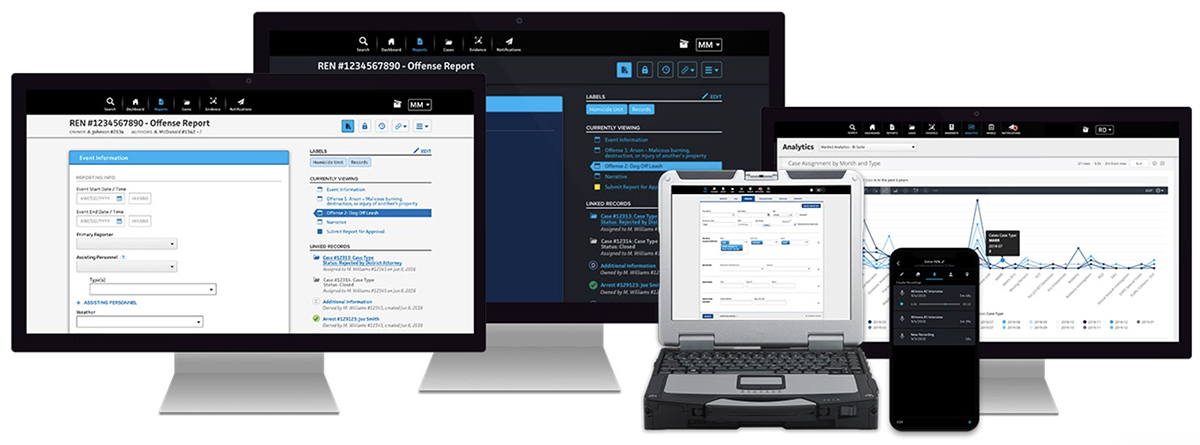
Look to the cloud.
With restrictive budgets, public safety agencies often do not have the funds necessary to build comprehensive IT teams.
The most effective way to augment IT resources is by leveraging the cloud. Government cloud providers employ the world’s top cybersecurity experts and spend more than a billion dollars a year in cyber defense.
Hacks happen. Be ready to respond.
All organizations must have a crisis plan designed specifically for cyberattack.
These plans, and the appropriate responses, will vary depending on the type of ransomware attack, but many cyber business continuity and disaster recovery (BC/DR) plans include these critical elements:
-
Data backups that are physically and virtually separate from primary systems
-
Crisis communication and liaison plan for impacted stakeholders
-
Cyber insurance policy
-
Contact information for the closest FBI field offices
In 2022, more government agencies will be making headlines because of cyberattacks.
Leading public safety agencies will continue to refine their cybersecurity strategies and increase their cyber defense today — because tomorrow may be too late.
Key takeaways
1. Clearly define a cybersecurity strategy and seek out vendors with proven security records
2. Make the cloud your first line of cybersecurity
3. Develop a BC/DR plan
Trend #6: Consent decrees are here to stay
The U.S. Department of Justice (DOJ) has used consent decrees and settlement agreements to bring reforms to agencies where there is a practice and pattern of misconduct.
In 2022, it is expected that the use of consent decrees will expand, due to calls for state attorneys general to conduct their own investigations within their jurisdiction.
(Four years after Baltimore and the Justice Department agreed to a consent decree to mandate police reforms, NBC News’ Tom Llamas looks into how things have changed for the police department and the community. An officer says he believes the reforms are working, however some in the city say the process is slow, or that they haven’t noticed a difference. Courtesy of NBC News and YouTube. Posted on Jul 5, 2021.)
Avoiding a consent decree.
While a singular event can trigger an investigation and subsequent consent decrees, they specifically target allegations of systemic police misconduct.
Agencies best positioned to avoid triggering a DOJ investigation are those who demonstrate a commitment to constitutional policing, practice policing by consent, and embrace a culture of reform and innovation.
Additionally, agencies would be wise to engage in the following:
-
Review policy and procedures to ensure they adhere to 21st century best practices.
-
Maintain a relationship with the community based on trust and transparency. The time to build these relationships is before, not after, the incident.
-
Demonstrate there is no pattern or practice of unconstitutional policing through data capture, analysis, and reporting.
The Crime and Justice Institute (CJI) has identified the 3 types of incidents most commonly addressed by consent decrees and how to address them.
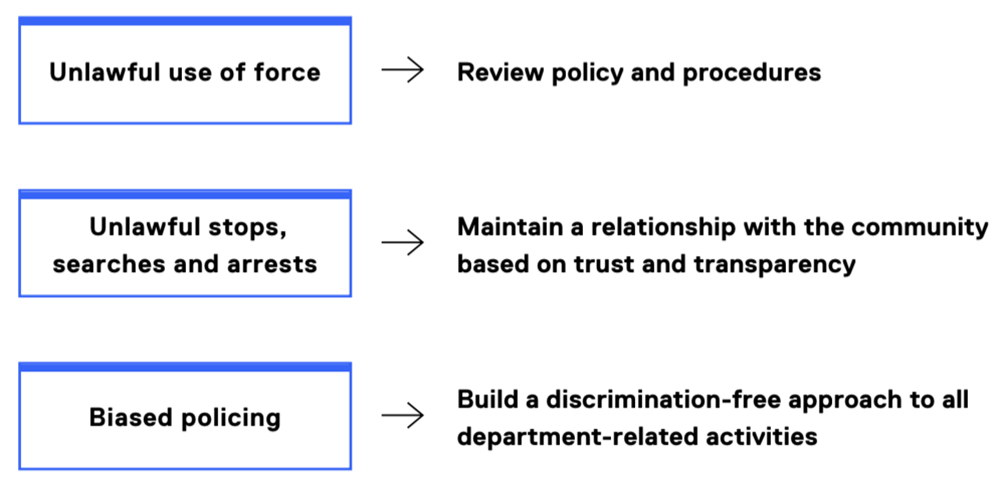
Survive the experience and thrive as an agency.
Successfully emerging from a consent decree requires a collaborative approach and intensive data collection and analysis.
-
A consent decree is an agreement, and agencies should ask for a seat at the proverbial
-
negotiation table.
-
Compliance and collaboration with the monitoring team is a must. Failure to do so will only lead to costly delays — often lasting for years — and further alienate the community.
-
Dedicate staff, facilities, and resources to collaborate with the DOJ and monitors.
-
Prioritize data collection, analysis, and reporting. Data sharing with the community helps to mend relationships and is an opportunity for agencies to tell their stories to the public.
After the consent decree, the goal is to embed a culture of reform and innovation in the organization.
When the monitor leaves, it is up to the agency to continue the data capture and analysis for ongoing innovation, self-aware critiques, and regular communication and collaboration with the community.
(After missing nearly 40% of its deadlines in the last reporting period, Chicago Police officials on Wednesday expressed confidence that the department’s compliance with its court-mandated reforms was improving. Courtesy of WGN News and YouTube. Posted on Sep 8, 2021.)
Key takeaways
-
Avoid consent decrees by engaging in and tracking constitutional policing activity and building community trust
-
Commit to intensive data collection, analysis, and sharing
-
Discover opportunities in the consent decree to embed a culture of reform and innovation into your organization
Public safety agencies find themselves in a rapidly changing environment. As a result, public safety will look very different in 2022 and beyond.
At Mark43, their solutions help public safety agencies address the unique challenges they face, and are constantly growing and improving to keep up with the changing world of public safety.
Mark43 is a source of support, care, guidance, and stability as agencies determine to best serve their communities.
They are also a thought leader helping agencies innovate by looking ahead, analyzing developing trends, and partnering with customers, citizens, non-profits, and academic institutions to drive impact.
Despite the many challenges facing public safety agencies, Mark43 believes the outlook is a positive one.
Leading agencies can and will meet these challenges by looking to the trends outlined above while protecting and serving their communities.
Mark43 builds the world’s most powerful public safety computer-aided dispatch (CAD), records management system (RMS), analytics, property and evidence, and mobile public safety platform with providing industry-leading customer care.
Public safety has changed in the last 30 years. Technology vendors haven’t. Mark43 provides a refreshing, battle-tested, enterprise implementation experience and product for more than 70 public safety agencies of all sizes, with a special competency for major agencies.
The cloud-native products are built with the most modern technologies and are constantly updated, guaranteeing that the Mark43 platform always outpaces the rest of the market.
To Learn More, please visit www.mark43.com. To download the complete Mark43 2022 Public Safety Trend Report click here.
Mark43 Takes Home the Gold in 2021 ‘ASTORS’ Homeland Security Awards Program

American Security Today’s Annual ‘ASTORS’ Awards is the preeminent U.S. Homeland Security Awards Program, and now in its Sixth Year, continues to recognize industry leaders of Physical and Border Security, Cybersecurity, Emergency Preparedness – Management and Response, Law Enforcement, First Responders, as well as federal, state and municipal government agencies in the acknowledgment of their outstanding efforts to Keep our Nation Secure.
Mark43

-
Best Public Safety Workforce Management
-
Mark43 Product Suite
-
Mark43, a cloud-native public safety software company, offers a single-platform Computer-Aided Dispatch (CAD) and Records Management System (RMS) for seamless data entry and faster reporting that are a natural extension of the dispatcher, call taker, and in-field first responder during an emergency response.

-
Additionally, the Mark43 Product Suite includes Mark43 Analytics, which centralizes CAD and RMS data in real-time enables agencies to make informed, data-driven decisions.
-
Mark43 partners with over 120 public safety agencies of all sizes in the U.S. and abroad and uses its platform to support the demands of any mission.
-
By providing fast, powerful technology Mark43 enables first responders to focus on their most important work–keeping communities safe.
(See how Mark43 is building software for the future of law enforcement and public safety. The company envisions a world where all officers are able to collect and share data in real-time, from the scene and back at the station. As law enforcement evolves, Mark43 adapts.. Courtesy of Mark43 and YouTube.)
The Annual ‘ASTORS’ Awards highlight the most cutting-edge and forward-thinking security solutions coming onto the market today, to ensure our readers have the information they need to stay ahead of the competition and keep our Nation safe – one facility, street, and city at a time.
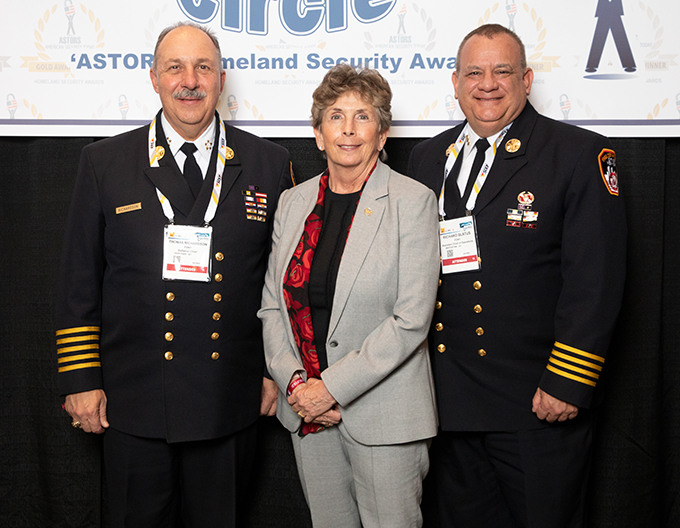
AST Honors Thomas Richardson, FDNY Chief of Department; Dr. Kathleen Kiernan, President of NEC National Security Systems; and Richard Blatus, FDNY Assistant Chief of Operations, at the 2021 ‘ASTORS’ Awards Luncheon at ISC East.
The United States was forever changed after the September 11th attacks, and we were fortunate to have many of those who responded to those horrific tragedies join us at the 2021 ‘ASTORS’ Awards Luncheon.
In the days that followed 9/11, the critical needs of protecting our country catapulted us into new and innovative ways to secure our homeland – which is how many of the agencies and enterprise organizations that are today ‘ASTORS’ Awards Champions, came into being.

Our 2021 keynote speaker featured a moving and informative address from TSA Administrator and Vice-Admiral of the United States Coast Guard (Ret), David Pekoske; to our attendees who traveled from across the United States and abroad, on the strategic priorities of the 64,000 member TSA workforce in securing the transportation system, enabling safe, and in many cases, contactless travel.

Legendary Police Commissioner William Bratton of the New York Police Department, the Boston Police Department, and former Chief of the Los Angeles Police Department was also live at the event, meeting with attendees and signing copies of his latest work ‘The Profession: A Memoir of Community, Race, and the Arc of Policing in America,’ courtesy of the generosity of our 2021 ‘ASTORS’ Awards Premier Sponsors.
The 2021 ‘ASTORS’ Awards Program was Proudly Sponsored by AMAROK, Fortior Solutions, and SIMS Software, along with Returning Premier Sponsors ATI Systems, Attivo Networks, Automatic Systems, and Reed Exhibitions.
The continually evolving ‘ASTORS’ Awards Program will emphasize the trail of Accomplished Women in Leadership in 2022, as well as the Significance and Positive Impact of Advancing Diversity and Inclusion in our Next Generation of Government and Industry Leaders. #MentorshipMatters
So be on the lookout for exciting upcoming announcements of Speakers, Presenters, Book Signing Opportunities, and Attendees at the 2022 ‘ASTORS’ Awards Presentation Luncheon in November of 2022 in New York City!
2022 ‘ASTORS’ Awards Program Welcomes New PLATINUM SPONSOR: NEC National Security Systems (NSS)!
Nominations are currently being accepted for the 2022 ‘ASTORS’ Homeland Security Awards at https://americansecuritytoday.com/ast-awards/.
Comprehensive List of Categories Include:
| Access Control/ Identification | Personal/Protective Equipment | Law Enforcement Counter Terrorism |
| Perimeter Barrier/ Deterrent System | Interagency Interdiction Operation | Cloud Computing/Storage Solution |
| Facial/IRIS Recognition | Body Worn Video Product | Cyber Security |
| Video Surveillance/VMS | Mobile Technology | Anti-Malware |
| Audio Analytics | Disaster Preparedness | ID Management |
| Thermal/Infrared Camera | Mass Notification System | Fire & Safety |
| Metal/Weapon Detection | Rescue Operations | Critical Infrastructure |
| License Plate Recognition | Detection Products | COVID Innovations |
| Workforce Management | Government Security Programs | And Many Others to Choose From! |
Don’t see a Direct Hit for your Product, Agency or Organization?
Submit your category recommendation for consideration to Michael Madsen, AST Publisher at: mmadsen@americansecuritytoday.com.
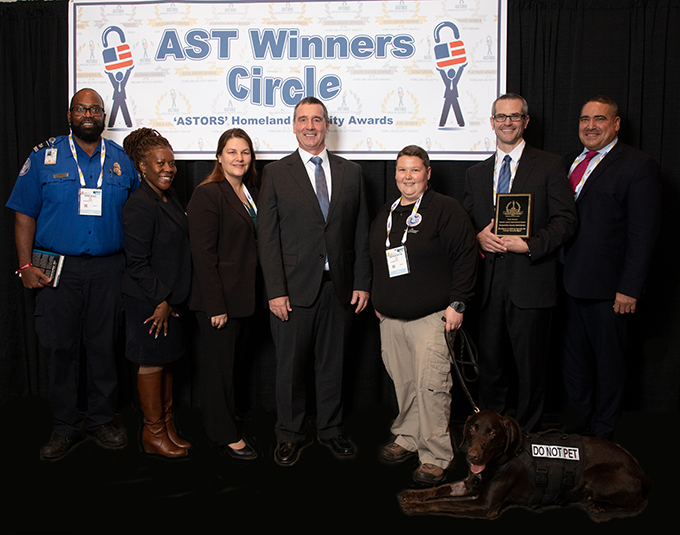
In 2021 over 200 distinguished guests representing Federal, State, and Local Governments, and Industry Leading Corporate Firms gathered from across North America, Europe, and the Middle East to be honored among their peers in their respective fields which included:

- The Transportation Security Administration (TSA)
- ICE Homeland Security Investigations (ICE HSI)
- Customs & Border Protection (CBP)
- The Federal Protective Service (FPS)
- Argonne National Laboratory (ANL)
- DHS Science & Technology (S&T)
- The National Center for Disaster Medicine & Public Health (NCDMPH)
- The American Red Cross
- The InfraGard National Alliance
- The Metropolitan Police (MPD)
- The U.S. Fire Administration (USFA)
- Naval Postgraduate School Center for Homeland Defense and Security (CHDS)
- The Federal Air Marshals Service
- The San Diego Harbor Police Foundation, and Many More!
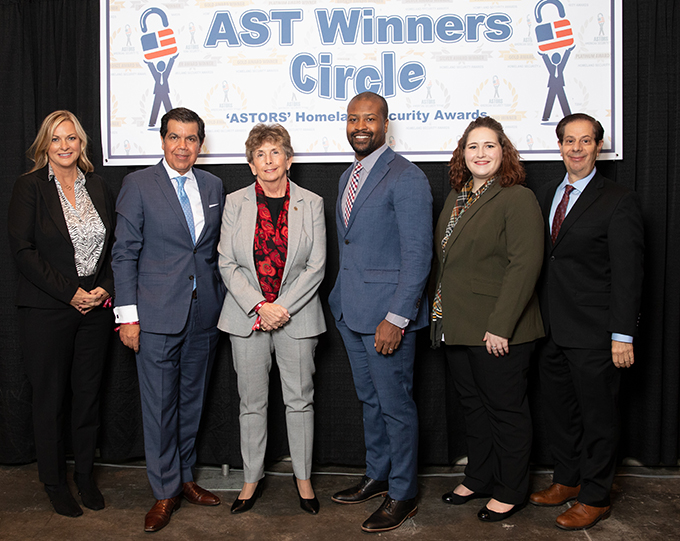
Corporate firms, the majority of which return year to year to build upon their record of accomplishment include:
AlertMedia, Allied Universal, AMAROK, ATI Systems, Attivo Networks, Axis Communications, Automatic Systems of America, BriefCam, Canon U.S.A., Fortior Solutions, guardDog.ai, Hanwha Techwin of America, HID Global, Mark43, IPVideo Corporation, Konica Minolta Business Solutions, Lumina Analytics, NEC National Security Systems, NICE Public Safety, OnSolve, PureTech Systems, Quantum Corporation, Rave Mobile Safety, Regroup Mass Notification, Robotic Assistance Devices, Rajant Corporation, SafeLogic, Senstar Corporation, ShotSpotter, Singlewire Software, SolarWinds Worldwide, Teledyne FLIR, Valor Systems, and Wiresecure, just to name a few!

Why American Security Today?
The traditional security marketplace has long been covered by a host of publications putting forward the old school basics to what is Today – a fast-changing security landscape.
American Security Today is uniquely focused on the broader Homeland Security & Public Safety marketplace with over 75,000 readers at the Federal, State, and local levels of government as well as firms allied to the government.
American Security Today brings forward a fresh compelling look and read with our customized digital publications that hold readers’ eyes throughout the story with cutting-edge editorial that provides solutions to their challenges.
Harness the Power of the Web – with our 100% Mobile Friendly Publications

AST Digital Publications are distributed to over 75,000 qualified government and homeland security professionals, in federal, state, local, and private security sectors.
‘PROTECTING OUR NATION, ONE CITY AT A TIME’
AST Reaches both Private & Public Experts, essential to meeting these new challenges.
Today’s new generation of public safety and security experts need real-time knowledge to deal with domestic and international terrorism, lone wolf attacks, unprecedented urban violence, shifts in society, culture, and media bias – making it increasingly difficult for Homeland Security, Law Enforcement, First Responders, Military and Private Security Professionals to implement coordinated security measures to ensure national security and improve public safety.
These experts are from Government at the federal, state, and local levels as well as from private firms allied to the government.
AST provides a full plate of topics in our AST Monthly Magazine Editions, AST Website, and AST Daily News Alerts, covering 23 Vital Sectors such as Access Control, Perimeter Protection, Video Surveillance/Analytics, Airport Security, Border Security, CBRNE Detection, Border Security, Ports, Cybersecurity, Networking Security, Encryption, Law Enforcement, First Responders, Campus Security, Security Services, Corporate Facilities, and Emergency Response among others.
AST has Expanded readership into integral Critical Infrastructure audiences such as Protection of Nuclear Facilities, Water Plants & Dams, Bridges & Tunnels, and other potential targets of terrorism.
Other areas of concern include Transportation Hubs, Public Assemblies, Government Facilities, Sporting & Concert Stadiums, our Nation’s Schools & Universities, and Commercial Business Destinations – all enticing targets due to a large number of persons and resources clustered together.
(See just a few highlights of American Security Today’s 2021 ‘ASTORS’ Awards Presentation Luncheon at ISC East. Courtesy of My Pristine Images and Vimeo.)
To learn more about ‘ASTORS’ Homeland Security Award Winners solutions, please see the 2021 ‘ASTORS’ CHAMPIONS Edition Fully Interactive Magazine – the Best Products of 2021 ‘A Year in Review’.
The Annual CHAMPIONS edition includes a review of Annual ‘ASTORS’ Award Winning products and programs, highlighting key details on many of the winning firm’s products and services, including video interviews and more.
It serves as your Go-To Source throughout the year for ‘The Best of 2021 Products and Services‘ endorsed by American Security Today, and can satisfy your agency’s and/or organization’s most pressing Homeland Security and Public Safety needs.
From Physical Security (Access Control, Critical Infrastructure, Perimeter Protection, and Video Surveillance Cameras and Video Management Systems), to IT Security (Cybersecurity, Encryption, Data Storage, Anti-Malware, and Networking Security – Just to name a few), the 2021 ‘ASTORS’ CHAMPIONS EDITION has what you need to Detect, Delay, Respond to, and Mitigate today’s real-time threats in our constantly evolving security landscape.
It also includes featured guest editorial pieces from some of the security industry’s most respected leaders, and recognized firms in the 2021 ‘ASTORS’ Awards Program.
-
For a complete list of 2021 ‘ASTORS’ Award Winners, begin HERE.
For more information on All Things American Security Today, as well as the 2021 ‘ASTORS’ Awards Program, please contact Michael Madsen, AST Publisher at mmadsen@americansecuritytoday.com.
-
*Mark43 was also recognized in the 2020, and 2019 ‘ASTORS’ Homeland Security Awards Programs.
1 Frendak, G. (2021, November 8). Albuquerque hotels take homelessness issue to City Council. KOB 4.
2 Bacon, J. (2021, November 1). Philadelphia to become first major U.S. City to ban minor traffic stops to promote equity, curb ‘negative interactions’ with police. USA Today.
3 The Stanford Open Policing Project. (n.d.). The Stanford Open Policing Project Findings.
4 Resources. Taking the Call. (n.d.). Retrieved from takingthecall.csgjusticecenter.org/resources/.
5 Brenan, M. (2021, November 12). Amid pandemic, confidence in key U.S. institutions surges. Gallup.
6 Police Foundation. 2018. Part III: Sharing Open Data. Open Data and Policing: A Five-Part Guide to Best Practices. Washington, DC: Office of Community Oriented Policing Services.
7 Ander, R., Goel, S., Heu-Weller, M., Keesee, T., & Overmann, L. (2020). Reimagining Policing: Data in Policing: Collection, Transparency, and Civil Liberties. Obama Foundation.
8 Singh, S. (2019, January 9). Here are three ways the private sector can act as a sustainability catalyst for globalization 4.0. World Economic Forum.
9 United States Census Bureau, Racial and Ethnic Diversity in the United States: 2010 Census and 2020 Census (2021).
10 National Fire Prevention Association. (2020, February 25). While the number of women is increasing, females still make up less than 10 percent of the U.S. fire service.
11 30×30 Initiative. (2021, November 8). Advancing Women in Policing. About the 30×30 Initiative.
12 Escamilla, J., & Reichert, J. (2019). An Overview of Police Technology: Adoption and Efficacy. Chicago, IL: Illinois Criminal Justice Information Authority Center for Justice Research and Evaluation.
13 Axelrod, J. (2021, March 22). Report: Ransomware attacks cost local and state governments over $18 billion in 2020. American City and County.
AST strives to meet a 3 STAR trustworthiness rating, based on the following criteria:
- Provides named sources
- Reported by more than one notable outlet
- Includes supporting video, direct statements, or photos













